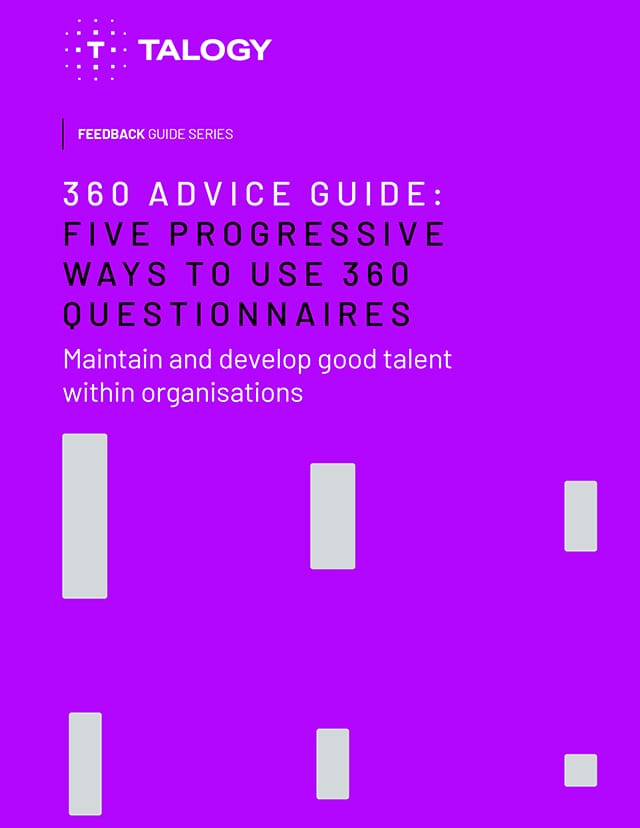Written by Paul Glatzhofer, VP of Talent Solutions
Giving feedback is not always easy, and certain people are just naturally better at it than others. However, over the years, I have trained hundreds of people on how to give feedback. With practice and guidance, anyone can develop this skill.
An obvious but often-overlooked consideration is to come to the meeting prepared. We are all busy, but make sure to set aside time to review the results in advance. To make the 360 as effective as possible, you want to come armed with a plan. You don’t want the first time that you’re analysing the aggregated data to be only just before or, even worse, during the discussion.
Once you’ve completed this prep, you’ll be ready to employ the tips below for providing feedback that can be can put into practice regardless of how many or how few times you’ve delivered feedback.
Before you get started:
- Be clear about your intentions. Set the stage for the conversation by re-stating the goals of the 360 process while also reminding them not to take any constructive feedback personally. Every single employee has room for improvement regardless of level, experience, or position.
- Ask the person receiving feedback for his or her own strengths and weaknesses. Soliciting this up front sets the tone for the rest of the meeting, as employees are frequently more aware of these attributes than they realise. These examples will help to shape the rest of the discussion, as feedback from their supervisor, peers, and subordinates will probably align and can be referred back to, solidifying where they excel and where they can improve.
- Start the conversation with strengths. Most of us would prefer to hear about things that we do well over those where we have room for improvement. Beginning the process with positive news will serve as a reminder that they are doing certain things well prior to delivering the constructive feedback.
During the feedback process:
- Make it a two-way conversation and encourage questions. No one enjoys a meeting where they feel as if they are being talked at, particularly when it comes to personal feedback. Creating a back-and-forth dialogue will make it feel less formal and put the recipient more at ease.
- Remember that there are positives and negatives to each piece of feedback. For example, someone very high in attention to detail may not be able to be a visionary for the future. In that case, work with them to provide suggestions on how to get their nose out of the details and short-term approach to see the longer-term implications. Point out that both approaches are important, but the ultimate goal is to achieve a balance between the two.
- Be objective, genuine, and non-judgmental. Your delivery is incredibly important, because you don’t want them to walk away feeling discouraged. That is clearly not the goal of this exercise and they will be much less likely to make positive changes if they feel like they’ve been verbally ‘beaten up.’ It may sound obvious, but be kind and direct throughout this whole interaction.
- Use behavioural examples and refer to job context – and be specific. If you’re anything like me, examples can make a huge difference in terms of my follow-through. If I feel that I know how to put some of these suggestions into action, I’m much more likely to actively make a change. If I feel that it’s more abstract, I will struggle to make any real progress. Put the feedback into digestible pieces that are easy to understand.
- Be constructive – focus on the future and next steps. Remind them that this isn’t meant to make them feel as if they’re on trial, but to simply address areas where improvements can be made. Phrase your feedback in a positive way, like “once you’ve mastered that skill, you can think about working on this skill.” It makes improvements seem achievable while encouraging them to break up the development feedback into smaller goals instead of trying to work on everything at once.
- Praise their strengths but don’t be afraid or hesitant to give developmental feedback. While “great work!” comments are certainly warranted, you will be getting far less utility out of this exercise if you aren’t devoting some time to the identified weaknesses. We can’t forget that a 360 by name alone indicates a well-rounded view of the employee and their work style, both the good and the bad.
- Always end on a positive note. An easy example would be: “You have some great strengths here – let’s focus on a few areas to help you be even more successful.” You want them to feel good about what they are doing well within their job and empowered to improve in the areas where they may have gaps.
After the feedback process:
- BONUS TIP: Make it stick. Leaving this meeting should not be the last time that these recommendations are discussed. Work this feedback into the employee’s individualised development plan and make it a point to review their progress at least once a quarter.
As the intermediary between those who completed the survey and the recipient, you serve a very important role. While not always the most comfortable discussion to have, you can make or break the effectiveness of this entire process. No pressure, I know, but all the more important for you to hone your skills as the one delivering the results.




